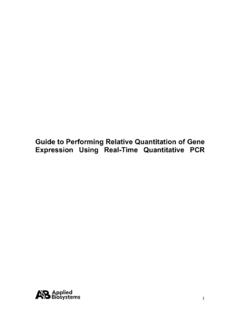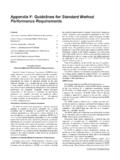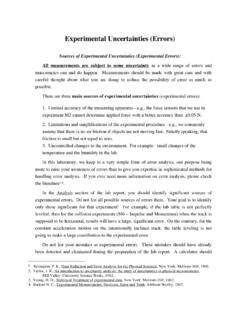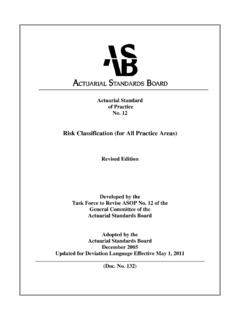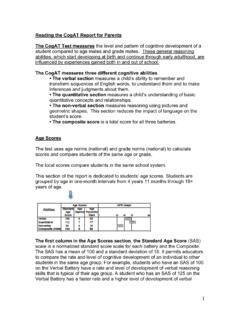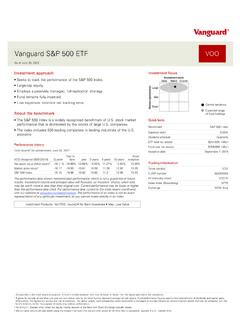Transcription of A Guide to Validation in HPLC - Weebly
1 Van Iterson Drenthe College Emmen Holland for A Guide to Validation in hplc Based on the work of G. M. Hearn PERKIN ELMER 1. Introduction Sometimes you may wonder who was the first to make an experimental procedure for a specific analysis. The route from an idea to an actual standard operating procedure (SOP) is not easy. In the early days it was a long period of trial and error to establish a document where common users could benefit from. Nowadays the use of computer programmes like Drylab or HIPAC makes it easier to optimize the intended procedure to a practical analysis for other laboratories and schools.
2 This document will try to explain some of the basic jargon and glossary concerning hplc . At the end you may understand the long route to a method that has been validated as have many of the experiments and analytical procedures you will use within StandardBase. 2 METHOD Validation " Validation of an analytical method is the process by which it is established by laboratory studies, that the performance characteristics of the method meet the requirements for the intended analytical application - "(6) Validation is required for any new or amended method to ensure that it is capable of giving reproducible and reliable results, when used by different operators employing the same equipment in the same or different laboratories.
3 The type of Validation programme required depends entirely on the particular method and its proposed applications. Typical analytical parameters used in assay Validation include: 1. Precision 2. Accuracy 3. Linearity 4. Range 5. Ruggedness 6. Limit of detection 7. Limit of quantitation 8. Selectivity 9. Specificity van Iterson Drenthe College Emmen Holland for Precision "The precision of an analytical method is the degree of agreement among individual test results obtained when the method is applied to multiple sampling of a homogenous sample -"(6) Precision is a measure of the reproducibility of the whole analytical method (including sampling, sample preparation and analysis) under normal operating circumstances.
4 Precision is determined by using the method to assay a sample for a sufficient number of times to obtain statistically valid results (ie between 6 - 1 0). The precision is then expressed as the relative standard deviation std dev x 100% %RSD = mean Accuracy "Accuracy is a measure of the closeness of test results obtained by a method to the true value. " (6) Accuracy indicates the deviation between the mean value found and the true value. lt is determined by applying the method to samples to which known amounts of analyte have been added. These should be analysed against standard and blank solutions to ensure that no interference exists.
5 The accuracy is then calculated from the test results as a percentage of the analyte recovered by the assay. Accuracy and precision are not the same, as the diagram below indicates. A method can have good precision and yet not be accurate. Errors in measurement can be divided into two general categories: systematic errors and van Iterson Drenthe College Emmen Holland for random errors. Systematic errors result from sources that can be traced to the methodology, the instrument or the operator, and affect both the accuracy and the precision of the measurement.
6 Random errors only affect the precision, and are difficult to eliminate, because they are the result of random fluctuations in the measured signal, due to noise and other factors. Whilst systematic errors are proportional to the sum of individual contributions, random errors are proportional to the root of the sum of the squares of the individual contributions. Thus, the imprecision of the entire procedure is often dominated by the random errors of the most imprecise step. Linearity This is the method's ability to obtain results which are either directly, or after mathematical transformation proportional to the concentration of the analyte within a given range.
7 Linearity is determined by calculating the regression line using a mathematical treatment of the results (ie least mean squares) vs analyte concentration. Range The range of the method is the interval between the upper and lower levels of an analyte that have been determined with acceptable precision, accuracy and linearity. It is determined on either a linear or nonlinear response curve (ie where more than one range is involved, as shown below) and is normally expressed in the same units as the test results. van Iterson Drenthe College Emmen Holland for Ruggedness Ruggedness is the degree of reproducibility of results obtained by the analysis of the same sample under a variety of normal test conditions ie different analysts, laboratories, instruments, reagents, assay temperatures, small variations in mobile phase, different days etc.
8 (ie from laboratory to laboratory, from analyst to analyst.) Limit of Detection This is the lowest concentration in a sample that can be detected, but not necessarily quantitated, under the stated experimental conditions. The limit of detection is important for impurity tests and the assays of dosages containing low drug levels and placebos. The limit of detection is generally quoted as the concentration yielding a signal-to-noise ratio of 2:1 and is confirmed by analyzing a number of samples near this value (6) using the following equation. The signal-to-noise ratio (5) is determined by: s = H/h Where H = height of the peak corresponding to the component h = absolute value of the largest noise fluctuation from the baseline of the chromatogram of a blank solution.
9 Since the limit of detection is dependant on the signal-to-noise ratio, it can be improved by enhancing the analyte signal and reducing the detector noise. The signal (ie peak height) can be increased by selecting the optimum monitoring wavelength, increasing the injection volume or mass (below signal or column saturation), increasing the peak sharpness with high efficiency columns and by optimizing the mobile phase. For absorbance detectors, longer path lengths in the flow cell enhances sensitivity though often to the detriment of post column dispersion. Noise can be reduced by using high sensitivity detectors with low noise and drift characteristics, slower detector response time, mobile phases with low absorbance and pumps with low pulsation.
10 Limit of Quantitation This is the lowest concentration of analyte in a sample that can be determined with acceptable precision and accuracy. lt is quoted as the concentration yielding a signal-to-noise ratio of 1 0: 1 and is confirmed by analyzing a number of samples near this value (5). Selectivity and Specificity van Iterson Drenthe College Emmen Holland for Selectivity is the ability to measure accurately and specifically the analyte in the presence of components that may be expected to be present in the sample matrix. Specificity for an assay ensures that the signal measured comes from the substance of interest, and that there is no interference from excipient and/or degradation products and/or impurities.
